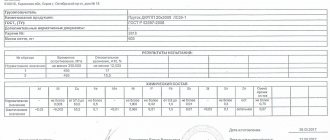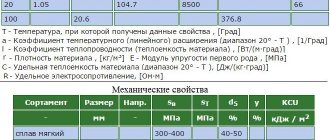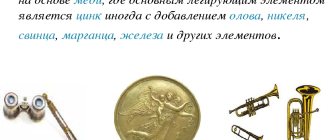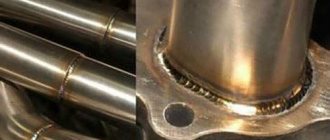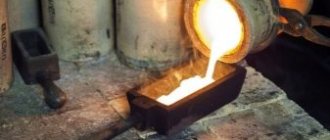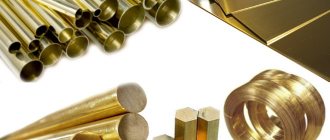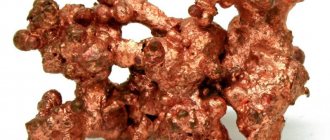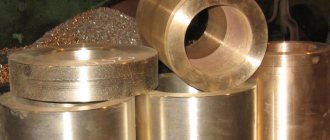Brass is a double or multi-component copper-based alloy alloyed with zinc
Brass is a corrosion-resistant alloy of zinc and copper that combines high strength with good machinability.
Copper is the basis of brass, determining the basic properties. Zinc is an alloying component, the percentage of which can reach 49%. The composition may contain other alloying elements, but their mass fraction is usually no more than 1.5%. Brass alloys have a bright yellow color that varies depending on the percentage of the main components. A successful combination of characteristics makes brass the optimal choice for the manufacture of pipes, profiles, plumbing fittings, parts of some mechanisms and other elements for which good corrosion resistance combined with strength is important. A characteristic feature of the production process is that about half of all zinc used comes from recycling plants. The surface of brass products can be easily polished, but darkens over time when exposed to air, so it is often varnished or nickel-plated.
Composition elements
The basis of brass is copper and zinc. In the most traditional composition of such an alloy, copper is contained in an amount of 70%, and zinc - 30%. There are brands of technical brass that contain 48–50 percent zinc. Typically, more than 50% of the zinc used for the production of brass alloys is obtained from waste of this metal.
Depending on the characteristics of the internal structure, alpha- and alpha-beta-type brasses are distinguished, which are also called single- and two-phase.
Their main differences are as follows.
- The chemical composition of brass alloys belonging to the alpha type contains 35% zinc.
- Alpha-beta brass (two-phase) consists of 47–50% zinc. They also contain lead, the amount of which does not exceed 6%.
Despite the fact that brass, also based on copper, is very similar in appearance to some brands of bronze, according to the professional classification it does not belong to bronze alloys. Some types of brass contain tin, the main alloying element of bronze, but it is added in very small quantities to improve certain characteristics of the alloy. In addition to tin, the chemical composition of certain brands of brass may contain elements such as lead, manganese, iron, nickel, etc., which can also improve its properties.
Content of chemical elements in simple (double) brasses (click to enlarge)
Content of chemical elements in lead brasses (click to enlarge)
Products made from brass have a beautiful golden-yellow color and are amenable to polishing and other types of machining. Depending on the grade of the alloy from which the product is made, the latter can be forged in a cold or heated state, but some types of this metal cannot be processed by plastic deformation methods. Despite the fact that brass is characterized by high corrosion resistance, the surface of products made of this metal, when exposed to the surrounding air for a long time, becomes covered with an oxide film and darkens. To prevent the surface of brass products from changing color over time, they are often coated with a protective layer of colorless varnish.
Dependence of characteristics on the composition of brass
The properties of brass are directly determined by the mass fractions of the main components. With a zinc content of up to 35%, brass has a single-phase structure (alpha phase), which is characterized by high ductility over a wide temperature range. With a larger proportion of zinc, brass alloys acquire a two-phase structure and become quite brittle under natural temperature conditions.
On sale are two-component grades, consisting only of zinc and copper, and multi-component grades - alloyed with additional chemical elements that modify their properties. Additional alloying components allow you to change individual characteristics, such as strength, toughness, ductility, etc.
- Brass mesh
- Brass square
- Brass sheets L63
- Brass sheets LS59-1
- Brass bands
- Brass rods L63
- Brass wire L63
- Brass pipes L63
- Brass hexagonal rods LS59-1
- Brass hexagonal rods L63
- Brass round bars LS59-1
- Brass wire LS59-1
- Brass pipes L68
What is the difference between brass and bronze
Both brass and bronze are copper alloys. The difference is that the main alloying element is zinc. In addition to zinc, brasses may contain aluminum, silicon, tin, lead, etc. Accordingly, brasses are called: aluminum, silicon, tin, lead, etc. brass. In any case, brass is based on a solid solution of zinc in copper, which determines its main properties: ductility, relatively high electrical and thermal conductivity, corrosion resistance, etc.
Brands of brass
- L63 - poorly processed by mechanical methods, used for the manufacture of nuts, bolts, machine parts and heating engineering elements;
- LS59-1 – well processed, used for the manufacture of nuts, bolts, gears and bushings.
The first grade is a two-component alloy with a mass fraction of zinc up to 37%. In the second, the zinc content reaches 40%, but despite this, it is more ductile and more technologically advanced due to additional alloying with lead.
What is the difference between single-phase and two-phase brass
Phase is a homogeneous part of the alloy with the same structure and properties. Brass, based on its structure, has a solid solution of zinc in the crystal lattice of copper. If the structure of brass is homogeneous (homogeneous), consisting only of a solid solution, then such brass is classified as single-phase (so-called α- and β-brass). At certain temperatures and concentrations of zinc, two-phase structures (α + β) are possible, as well as the separation of particles with an ordered structure - intermetallic compounds - from the solid solution.
The mechanical properties of these brasses also differ: α-brasses are more ductile, soft, and easily susceptible to large degrees of deformation, for example, by drawing. Typical representatives are L68, L80. β-brasses are harder and more durable, but also quite ductile.
In industry, two-phase brass is usually used, with additional alloying to create special properties. For example, LS59-1 - two-phase rolled brass, the price of which is slightly higher than those similar in copper content (L60, L63), contains lead, which does not dissolve in the copper lattice and increases machinability.
Manufacturability of brass
Copper- and zinc-based metals lend themselves well to machining, making it possible to turn any parts from blanks and preliminary castings. In addition, they lend themselves well to soldering.
The main disadvantage is the tendency for brass with a high zinc content (more than 20%) to crack, especially when used in a humid environment and in the presence of ammonia vapor. The first sign of a decrease in the strength of rolled brass metal is the loss of natural color; other properties gradually deteriorate.
Physical and mechanical properties
Alloy L63 is double, the structure is single-phase. Compared to copper, it has higher strength, hardness, ductility, elasticity and corrosion resistance. With increasing zinc content, these indicators increase. The greatest practical value for the crystallization of alloys based on copper and zinc are compounds with a zinc content of up to 50%. This number includes brass L63.
Structure
According to the Cu-Zn phase diagram, depending on the composition (zinc content from 0 to 39%), the material is a single-phase brass consisting of an a-solid solution with an equilibrium structure. This amount of zinc allows the alloy to crystallize in an equilibrium state, forming a face-centered cubic lattice (FCC), which achieves its plastic state. An increase in the zinc content in single-phase brasses is accompanied by an increase in their strength and ductility.
Plastic
The relative elongation of the material in the cold state, which characterizes its plasticity, is 55%. In the annealed state, L63 brass is the least ductile. But in the stage of applying cold deformation, plasticity persists for a long period. Higher plastic characteristics of the alloy are noticed when using soft stress state schemes during the deformation of the material, which is taken into account when predicting the possible destruction of the metal.
Susceptibility to processing
L63 is a single-phase alloy, in the b phase, which reduces the mechanical properties of products, contains a negligible amount of substance, and therefore lends itself well to pressure processing at low temperatures:
- minting;
- rolling;
- bending;
- deep drawing;
- drawing
The processed material requires strict adherence to the cooling regime.
Some alloy parameters
Compared to copper, the thermal conductivity and electrical conductivity of L63 brass due to the high zinc content is lower, and the workability is 2 times higher. The impact strength of the alloy is worse than that of L68, but better than that of multi-component brass.
Characteristics of brass L63:
- electrical resistivity – 0.065;
- impact strength – 14;
- machinability – 40%;
- thermal conductivity – 0.25.
The specific gravity of brass L63 is 8.44 g/cm3. The coefficient of friction with lubrication is 0.012, without lubrication - 0.390. Fluid flow - 65 cm, linear shrinkage - 1.77%. Brinnell hardness – 150-160 MPa.
Strength
Alloy L63 has the greatest strength in the cold state. The shear strength is 240 MPa. According to this indicator, the metal is inferior to brass L59-1. The tensile strength (ultimate strength) of double brass L63 in the state of extreme hardening is 735 MPa. The tensile strength of a hard alloy for rolling is in the range of 680-750 MPa, for a soft alloy - 380-450 MPa.
Melting temperature
The temperature range for thermomechanical and heat treatment of this metal is less than for other double brasses. The melting point of brass L63 is 906°C.
Due to the fact that with an increase in the zinc content in the brass alloy, the melting temperature decreases, in order to avoid burnout of the workpieces and their overheating, the temperature of hot processing is reduced to 750-880, and annealing - to 550-660°C.
At the same hot deformation temperature, brass L63 has the lowest values of deformation resistance. The conditional yield strength of the alloy is 700 MPa.
Temperature conditions for processing double brass grade 63:
- casting – 1060-1100°C;
- hot deformation – 650-850;
- beginning of recrystallization – 350-370;
- complete annealing – 660-670°C.
Corrosion resistance
Brass grade L63 in a cold state is subject to corrosion (seasonal) cracking and dezincification (dissolution in an aqueous environment). After the brass dissolves, due to an exchange reaction, copper precipitates from the solution. The copper film has a spongy appearance and creates a galvanic couple with brass, which accelerates the corrosion process. Dezincification occurs more intensively with increasing temperature of the environment and increasing the speed of water movement.
Causes
The main reasons leading to corrosion cracking of alloy L63:
- unfavorable environment (moisture and oxygen content, traces of ammonia, mercury salts, sulfur dioxide);
- the presence of residual tensile stresses in the metal;
Seasonal phenomena (autumn, spring), when air humidity and, accordingly, the ammonia content in it are increased, are considered especially unfavorable in terms of corrosion.
Internal residual stresses in the workpiece are divided into:
- the first kind (zonal), which are caused by the uneven distribution of deformations during pressure treatment of the material and uneven cooling of the workpiece after heat treatment;
- of the second kind, the causes of which are phase and structural transformations in the alloy.
Anti-cracking measures
To avoid corrosion cracking, use:
- low-temperature annealing of brass to reduce residual stress at 240-300°C;
- creation of compressive residual stresses in the outer layers of the workpieces;
carrying out other production activities aimed at reducing the limit of residual tensile stresses in the metal.
Resistance and instability to corrosion
L63 has increased anti-corrosion resistance in the following conditions:
- air environment;
- dry steam;
- fresh and sedentary sea water;
- dry halogen gas;
- alcohol, freon, antifreeze.
After processing on machines or by cutting, the L63 material loses its resistance to corrosion due to disruption of the crystal structure.
The instability of the alloy to corrosion cracking is observed upon contact:
- with mine waters;
- hydrogen sulfide;
- high pressure;
- fatty acids;
- wet saturated steam;
- oxidizing solutions;
- mineral acids;
- chlorides.
Thin-walled products are most susceptible to corrosion. It is not recommended to use L63 alloy in contact with zinc, aluminum and iron to avoid its accelerated destruction.
Ways to improve the characteristics of brass alloys
The fragility of the alloy can be significantly reduced by annealing, carried out in the temperature range of 240-260 °C. During heat treatment, the strength properties of the material are improved and residual stress is eliminated. The main way to influence performance characteristics (strength, density, ductility, color, etc.) is the introduction of alloying components.
A pure alloy of zinc and copper is called two-component; if alloying elements are present in the composition, it is called multi-component. The most common alloying additives are lead, silicon, nickel, iron, tin and manganese. Their percentage is usually small (up to 1-1.5%), but the characteristics change dramatically. If you exceed the norm, the quality of brass metal products can significantly deteriorate.
The introduction of silicon and lead makes it possible to improve the strength and antifriction characteristics of brass, due to which the wear resistance of mechanical parts made from it significantly increases. If the mass fraction of silicon exceeds technical standards, the characteristics of brass may deteriorate sharply. Also, lead and silicon, when proportioned, can improve the aesthetic properties of the material.
Tin, aluminum and manganese increase tensile adaptability, and the addition of iron and manganese increases the elongation rate. It is important to note here that all other alloying additives have a negative effect on the elongation index.
To increase the anti-corrosion properties, nickel, tin, manganese and aluminum are added to brass alloys. The addition of nickel helps prevent cracking in high humidity conditions. An additional positive effect of tin alloying is to increase strength, density and resistance to sea water and salt spray. Therefore, such materials are used in devices intended for shipping.
Alloying with lead increases ductility and manufacturability, making brass easier to machine cut. When processed on a lathe, the workpieces do not crack. The chips are small and the surface is almost perfectly smooth, so the finished part does not require finishing.
Arsenic is rarely used as an alloying component for zinc and copper alloys. Typically, parts alloyed with it are used to work in aggressive chemical environments. If iron and nickel are added to the alloy simultaneously with arsenic, the durability of the finished product increases significantly, and it can work in contact with weak solutions of alkalis and acids.
Application
Brass L63 is used for the manufacture of:
- pipes;
- sheets;
- wires;
- ribbons;
- foil;
- stripes;
- parts produced by deep drawing.
Finished products:
- pressure rollers for pickling work;
- tanks;
- screws;
- car parts;
- radiator tapes;
- zippers;
- fasteners;
- decorative elements of architecture and design;
- shut-off valve units;
- electrodes;
- rivets;
- couplings.
The material is most often used in the production of parts made by deformation with high requirements for corrosion resistance. Brass is used for welding, soldering, and processed on machines. The alloy is used to create church utensils, make costume jewelry, decorate books, and use them for monuments. Due to its similarity to gold, it is used as a counterfeit for making jewelry.
Rolled brass l63
- Rods: hard (diameter 3-12 mm), semi-hard (3-40 mm), soft (3-50 mm), pressed (10-180 mm).
- Circles for mass use.
- General purpose pipes (pressed and cold-formed).
- Boiler pipes.
- Mass-produced wire (conditions - soft, hard, semi-hard), with a diameter of 0.1-12 mm. Used as solder and for rivets.
High-precision L63 wire is used in the form of electrodes for electrical discharge machines. Plates are made from a sheet of this alloy, which become personalized when engraved.
Decorative use
Brass alloy L63, thanks to its beautiful golden-yellow color, is used for the manufacture of artistic products. They are coated with varnish, which gives the item a golden shine. Brass is galvanized - coated with silver, nickel, gold, and tinted in any color.
Brand L63 has the color of 583 gold, which is used in casting to imitate natural gold nuggets. The technology consists of casting a molten composition into cooled water in a large spatial form, not limited by walls. In this case, the casting acquires bizarre, uneven outlines, reminiscent of gold nuggets.
The shapes are obtained due to maximum cooling of the alloy in water at a temperature of 5-10°C. As a result of this process, with a sharp temperature difference, a high rate of crystallization of the outer layers of the casting occurs, deformation occurs, and an uneven surface is formed. In this case, the single-phase structure of the L63 alloy becomes similar to the structure of two-phase brasses, and the hardness of the material increases. Such castings can be used in jewelry design.
Casting brass alloys
There are two main types of brass alloys for mass consumption: casting and wrought (jewelry is also included in a separate group). The characteristics and processing technologies of casting brasses are described in GOST 17711. Materials of this type are characterized by increased density, reduced gas content and good corrosion resistance. Due to the partial evaporation of zinc during the casting process, the metal is well deoxidized, but it is important to control this process so that the characteristics of the finished product correspond to the calculated values.
Cast brasses are characterized by reduced segregation (heterogeneity that occurs during the casting and crystallization process), increased melt fluidity and a low shrinkage coefficient. In terms of mechanical characteristics, finished parts made from this metal are similar to products made from aluminum and tin bronze, while their cost is significantly lower due to a simpler production technology.
Of course, cast brass alloys also have certain disadvantages. Thus, during crystallization, quite large cavities can form on the surface of products, leading to a significant percentage of defects. It is also important to consider that due to the evaporation of zinc, smelting must be carried out using special fluxes.
According to the method of manufacturing products, a distinction is made between wrought and cast brass.
Wrought brasses are marked with the letter L, followed by a number indicating the percentage of copper content, for example, L62 brass contains 62% copper and 38% zinc. If, in addition to copper and zinc, there are other elements, then their initial letters are put (O - tin, C - lead, Zh - iron, F - phosphorus, Mts - manganese, A - aluminum, C - zinc). The amount of these elements is indicated by the corresponding numbers after the number indicating the copper content, for example, the LAZh60-1-1 alloy contains 60% copper, 1% aluminum, 1% iron and 38% zinc.
Single-phase a-brasses are used for the manufacture of parts by cold deformation. They produce tapes, cartridge cases, radiator tubes, and wire.
For the manufacture of parts by deformation at temperatures above 500oC, (a) – brass is used. Sheets, rods and other workpieces are made from two-phase brass, from which parts are made by subsequent mechanical processing. Cutting machinability is improved by adding lead to the brass composition, for example, brass grade LS59-1,
which is called “automatic brass”.
Brasses have good corrosion resistance, which can be further increased by adding tin. Brass LO70-
1 resistant against corrosion in sea water and is called “marine brass“.
The addition of nickel and iron increases the mechanical strength to 550 MPa.
Cast brasses are also marked with the letter L. After the letter designation of the main alloying element (zinc) and each subsequent one, a number is placed indicating its average content in the alloy. For example, LTs23A6Zh3Mts2 brass contains 23% zinc, 6% aluminum, 3% iron, 2% manganese. LTs16K4 brass has the best fluidity. Cast brasses include brasses of the LS, LK, LA, LAZH, LAZHMts types. Casting brass is not prone to segregation, has concentrated shrinkage, and castings are obtained with high density.
Brasses are a good material for structures operating at subzero temperatures.
Bronze
Alloys of copper with elements other than zinc are called bronzes.
Bronzes are divided into wrought and cast bronzes
.
When marking deformable bronzes, the letters Br are placed first ,
then letters indicating which elements, other than copper, are included in the alloy. After the letters there are numbers showing the content of components in the alloy. For example, the BrOF10-1 brand means that bronze contains 10% tin, 1% phosphorus, and the rest is copper.
The marking of cast bronzes also begins with the letters Br, then the letter designations of the alloying elements are indicated and a number is placed indicating its average content in the alloy. For example, BrO3Ts12S5 bronze contains 3% tin, 12% zinc, 5% lead, and the rest is copper.
Tin bronzes
When copper is alloyed with tin, solid solutions are formed. These alloys are very prone to segregation due to the wide temperature range of crystallization. Due to segregation, alloys with a tin content above 5% have a eutectoid component in their structure, consisting of soft and hard phases. This structure is favorable for parts such as sliding bearings: the soft phase ensures good running-in, hard particles create wear resistance. Therefore, tin bronzes are good anti-friction materials.
Tin bronzes have low volumetric shrinkage (about 0.8%), therefore they are used in artistic casting.
The presence of phosphorus ensures good fluidity.
Tin bronzes are divided into wrought and cast bronzes.
In wrought bronzes
the tin content should not exceed 6% to ensure the necessary ductility, BrOF6.5-0.15.
Depending on the composition, deformable bronzes are distinguished by high mechanical, anti-corrosion, anti-friction and elastic properties, and are used in various industries. Rods, pipes, tape, and wire are made from these alloys.
Foundry tin bronzes, BrO3Ts7S5N1, BrO4Ts4S17
, are used for the manufacture of steam-water fittings and for casting anti-friction parts such as bushings, worm wheel rims, and bearing shells.
Aluminum bronzes, BrAZH9-4, BrAZH9-4L, BrAZHN10-4-4.
Bronzes with an aluminum content of up to 9.4% have a single-phase a-solid solution structure. With an aluminum content of 9.4...15.6%, the alloys of the copper-aluminum system are two-phase.
Aluminum bronzes containing 5...8% aluminum have optimal properties. An increase in aluminum content to 10...11% due to the appearance of the – phase leads to a sharp increase in strength and a strong decrease in ductility. An additional increase in strength for alloys with an aluminum content of 8...9.5% can be achieved by hardening.
Positive features of aluminum bronzes compared to tin bronzes:
· less tendency to intracrystalline liquation;
· high density of castings;
· higher strength and heat resistance;
· less tendency to cold brittleness.
The main disadvantages of aluminum bronzes:
· significant shrinkage;
· tendency to form columnar crystals during crystallization and grain growth when heated, which embrittles the alloy;
To eliminate these shortcomings, the alloys are additionally alloyed with manganese, iron, nickel, and lead.
Relatively small but highly important parts such as gears, bushings, flanges are made from aluminum bronzes by casting and pressure treatment. Medals and small coins are made from BrA5 bronze by stamping.
Silicon bronzes, BrKMts3-1, BrK4
, are used as substitutes for tin bronzes. They are non-magnetic and frost-resistant, superior to tin bronze in corrosion resistance and mechanical properties, and have high elastic properties. The alloys are well welded and soldered. Due to their high resistance to alkaline media and dry gases, they are used for the production of waste pipes, gas and smoke pipes.
Lead bronze, BrS30
, used as a high-quality anti-friction material. Compared to tin bronzes, they have lower mechanical and technological properties.
Beryllium bronzes, BrB2,
are high quality spring material. The solubility of beryllium in copper decreases significantly with decreasing temperature. This phenomenon is used to obtain high elastic and strength properties of products using the dispersion hardening method. Finished products from beryllium bronzes are subjected to hardening from 800oC, due to which a supersaturated solid solution of beryllium in copper is fixed at room temperature. Then artificial aging is carried out at a temperature of 300...350oC. In this case, dispersed particles are released, strength and elasticity increase. After aging, the tensile strength reaches 1100...1200 MPa.
Wrought brasses are marked with the letter L, followed by a number indicating the percentage of copper content, for example, L62 brass contains 62% copper and 38% zinc. If, in addition to copper and zinc, there are other elements, then their initial letters are put (O - tin, C - lead, Zh - iron, F - phosphorus, Mts - manganese, A - aluminum, C - zinc). The amount of these elements is indicated by the corresponding numbers after the number indicating the copper content, for example, the LAZh60-1-1 alloy contains 60% copper, 1% aluminum, 1% iron and 38% zinc.
Single-phase a-brasses are used for the manufacture of parts by cold deformation. They produce tapes, cartridge cases, radiator tubes, and wire.
For the manufacture of parts by deformation at temperatures above 500oC, (a) – brass is used. Sheets, rods and other workpieces are made from two-phase brass, from which parts are made by subsequent mechanical processing. Cutting machinability is improved by adding lead to the brass composition, for example, brass grade LS59-1,
which is called “automatic brass”.
Brasses have good corrosion resistance, which can be further increased by adding tin. Brass LO70-
1 resistant against corrosion in sea water and is called “marine brass“.
The addition of nickel and iron increases the mechanical strength to 550 MPa.
Cast brasses are also marked with the letter L. After the letter designation of the main alloying element (zinc) and each subsequent one, a number is placed indicating its average content in the alloy. For example, LTs23A6Zh3Mts2 brass contains 23% zinc, 6% aluminum, 3% iron, 2% manganese. LTs16K4 brass has the best fluidity. Cast brasses include brasses of the LS, LK, LA, LAZH, LAZHMts types. Casting brass is not prone to segregation, has concentrated shrinkage, and castings are obtained with high density.
Brasses are a good material for structures operating at subzero temperatures.
Bronze
Alloys of copper with elements other than zinc are called bronzes.
Bronzes are divided into wrought and cast bronzes
.
When marking deformable bronzes, the letters Br are placed first ,
then letters indicating which elements, other than copper, are included in the alloy. After the letters there are numbers showing the content of components in the alloy. For example, the BrOF10-1 brand means that bronze contains 10% tin, 1% phosphorus, and the rest is copper.
The marking of cast bronzes also begins with the letters Br, then the letter designations of the alloying elements are indicated and a number is placed indicating its average content in the alloy. For example, BrO3Ts12S5 bronze contains 3% tin, 12% zinc, 5% lead, and the rest is copper.
Tin bronzes
When copper is alloyed with tin, solid solutions are formed. These alloys are very prone to segregation due to the wide temperature range of crystallization. Due to segregation, alloys with a tin content above 5% have a eutectoid component in their structure, consisting of soft and hard phases. This structure is favorable for parts such as sliding bearings: the soft phase ensures good running-in, hard particles create wear resistance. Therefore, tin bronzes are good anti-friction materials.
Tin bronzes have low volumetric shrinkage (about 0.8%), therefore they are used in artistic casting.
The presence of phosphorus ensures good fluidity.
Tin bronzes are divided into wrought and cast bronzes.
In wrought bronzes
the tin content should not exceed 6% to ensure the necessary ductility, BrOF6.5-0.15.
Depending on the composition, deformable bronzes are distinguished by high mechanical, anti-corrosion, anti-friction and elastic properties, and are used in various industries. Rods, pipes, tape, and wire are made from these alloys.
Foundry tin bronzes, BrO3Ts7S5N1, BrO4Ts4S17
, are used for the manufacture of steam-water fittings and for casting anti-friction parts such as bushings, worm wheel rims, and bearing shells.
Aluminum bronzes, BrAZH9-4, BrAZH9-4L, BrAZHN10-4-4.
Bronzes with an aluminum content of up to 9.4% have a single-phase a-solid solution structure. With an aluminum content of 9.4...15.6%, the alloys of the copper-aluminum system are two-phase.
Aluminum bronzes containing 5...8% aluminum have optimal properties. An increase in aluminum content to 10...11% due to the appearance of the – phase leads to a sharp increase in strength and a strong decrease in ductility. An additional increase in strength for alloys with an aluminum content of 8...9.5% can be achieved by hardening.
Positive features of aluminum bronzes compared to tin bronzes:
· less tendency to intracrystalline liquation;
· high density of castings;
· higher strength and heat resistance;
· less tendency to cold brittleness.
The main disadvantages of aluminum bronzes:
· significant shrinkage;
· tendency to form columnar crystals during crystallization and grain growth when heated, which embrittles the alloy;
To eliminate these shortcomings, the alloys are additionally alloyed with manganese, iron, nickel, and lead.
Relatively small but highly important parts such as gears, bushings, flanges are made from aluminum bronzes by casting and pressure treatment. Medals and small coins are made from BrA5 bronze by stamping.
Silicon bronzes, BrKMts3-1, BrK4
, are used as substitutes for tin bronzes. They are non-magnetic and frost-resistant, superior to tin bronze in corrosion resistance and mechanical properties, and have high elastic properties. The alloys are well welded and soldered. Due to their high resistance to alkaline media and dry gases, they are used for the production of waste pipes, gas and smoke pipes.
Lead bronze, BrS30
, used as a high-quality anti-friction material. Compared to tin bronzes, they have lower mechanical and technological properties.
Beryllium bronzes, BrB2,
are high quality spring material. The solubility of beryllium in copper decreases significantly with decreasing temperature. This phenomenon is used to obtain high elastic and strength properties of products using the dispersion hardening method. Finished products from beryllium bronzes are subjected to hardening from 800oC, due to which a supersaturated solid solution of beryllium in copper is fixed at room temperature. Then artificial aging is carried out at a temperature of 300...350oC. In this case, dispersed particles are released, strength and elasticity increase. After aging, the tensile strength reaches 1100...1200 MPa.
Wrought brass alloys
This category of zinc and copper alloys is pressure processed. The characteristics and technology of working with them are regulated by the GOST standard 15527. They are supplied in the form of rolled metal and blanks for subsequent processing and production of parts of the required shape. Additionally, there are two categories of copper-zinc alloys: double (two-component) and special (multicomponent). The two most popular grades of wrought alloys are L63 (two-component) and LS59-1 (multicomponent, alloyed with lead).
Based on their structure, single-phase and two-phase alloys are also distinguished. Single-phase brass has a uniform, unchangeable color and has good processability. Two-phase ones have increased density, they become more fragile and are less susceptible to cold processing. The melting point for all copper-containing alloys is approximately in the same range.
What types of rolled products are made from brass?
Due to the high ductility of deformable brass, the range of rolled products is very wide. You can buy rolled brass at METAL BUREAU at minimal prices in the form of forgings, sheets, strips, strips, profiles, pipes and wire. The range of each of these types of rolled products is regulated by its own standard. In particular, sheets and strips - GOST 931-90, strips - GOST 2208-91, rods - GOST 2060-90, pipes GOST 494-90, wire - GOST 1066-90. At the same time, the chemical composition of all pressure-processed brasses is subject to GOST 15527-2004.
Physico-chemical properties of brass alloys
In appearance, brass resembles bronze, which is why they are confused or even identified. But in bronze the main alloying component is tin, not zinc, so these are two completely different copper-containing metals with significantly different physicochemical properties.
Zinc (Zn, Zincum) is in position 30 in the periodic table. He is included in the secondary subgroup of the second group of the fourth period. Under normal conditions, pure zinc is a brittle metal with a characteristic bluish tint. In air it quickly oxidizes, and if a zinc stick is bent, a characteristic cracking sound is heard (in this way zinc resembles tin). Pure zinc does not occur in nature.
Copper (Cu, Cuprum) is located right in front of zinc in the periodic table - in 29th position. It belongs to the elements of the eleventh group of the fourth period. In its pure form, it is a soft, ductile metal of rose-gold color. Under natural conditions, the surface of purified copper quickly oxidizes, combining with atmospheric oxygen. Despite this, it is found in its native form, thanks to which it became one of the first metals known to man. The most ancient copper products found during excavations in the village of Catal Huyuk (Turkey) date back to 7500 BC.
Influence of the zinc proportion on the properties of brass alloy
The basic properties of the combination of zinc and copper depend on the percentage of the main components. Since pure copper is ductile, alloys with less than 30 percent zinc also have this property. An increase in the proportion of zinc gradually makes the metal more brittle, and with the appearance of the β'-phase, the brittleness increases sharply. In this case, the hardness increases up to 45 percent zinc content, after which this parameter sharply decreases.
Since one of the main forms of brass parts is pressure deformation, it is important to consider the ductility of the alloys used. Single-phase compositions retain plasticity and can be stamped at ordinary temperatures, but in the range of 300-700 °C they can acquire undesirable brittleness. Two-phase alloys acquire the ductility necessary for stamping only at temperatures exceeding 700 °C.
Melt brass technology
To obtain the melt, two main technologies are used:
- melting in crucibles made of refractory clay by heating in a flame or shaft furnace;
- melting in a reverberatory furnace without the use of crucibles.
Molten metal is poured into sand molds to produce blanks and ingots. It is important to consider that part of the zinc evaporates during the process, so it is necessary to choose an alloy in which its proportion will be slightly higher. The correction for evaporation is calculated individually for a specific technology so that the proportions of metals in the finished product correspond as much as possible to the design values.
Brass marking
To avoid confusion, the first letter in the marking of copper-zinc alloys is always “L”. If the alloy is two-component, then the marking consists only of this letter and two numbers indicating the percentage of copper. Thus, the marking of one of the most common alloys L63 implies 63% copper and up to 37% zinc (acceptable values are 62-65% for copper and 34-37.5 for zinc, the amount of other impurities is no more than 0.5%).
The addition of additional alloying components in significant quantities is also reflected in the designation of the alloy grade. The name of the main alloying component is also added to the name. For example, the popular brand LS59-1 is deciphered as follows:
- L – brass;
- C – lead;
- 59 – percentage of copper;
- 1 – lead content.
Decoding brass grades with a large number of components is done in a similar way. The letters after “L” indicate additional alloying impurities, and a hyphen (or several hyphens) indicates their weight percentages. For example, the marking LAZhMts70-5-3-1 implies the presence of 5% aluminum, 3% iron and 1% manganese. The share of zinc is respectively 20-21% (including 0.5-0.75% impurities).
What are the differences between cast and wrought brasses?
Firstly, in the production method. Foundry brass is intended for the production of castings of various shapes and purposes, and from deformable brass (more correctly, processed by pressure) rolled brass is produced.
Secondly, the alloying system. Wrought brasses are less alloyed and the copper content in them does not decrease below 59-60%. Aluminum and silicon are added to foundries to increase fluidity, they are more complexly alloyed, the copper content can be reduced to 53-55% (For example, LTs40Mn3Zh).
The markings of these types of brass differ slightly in spelling, for example, aluminum deformable - LAZH 60-1-1, cast - LTs37Mn2S2K.


